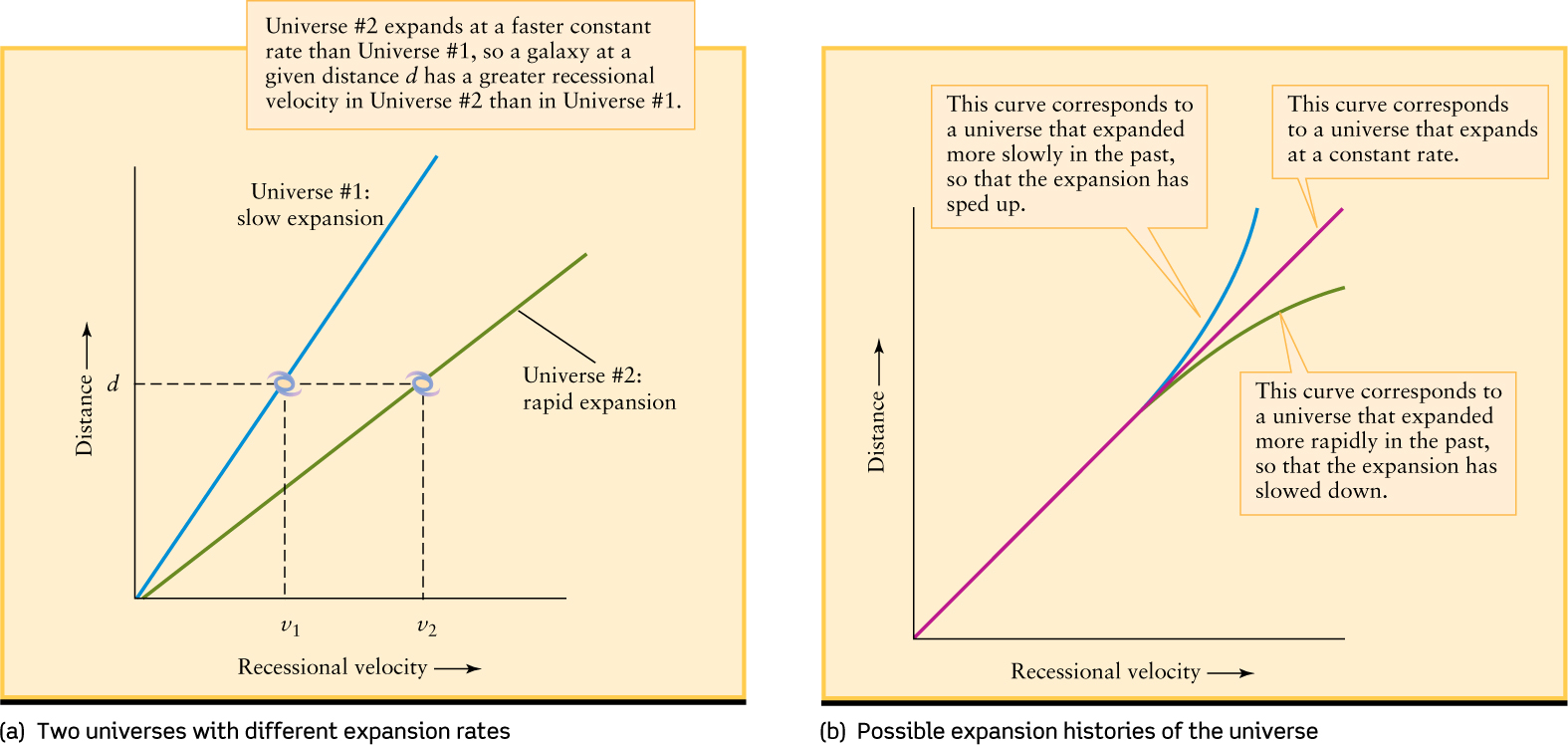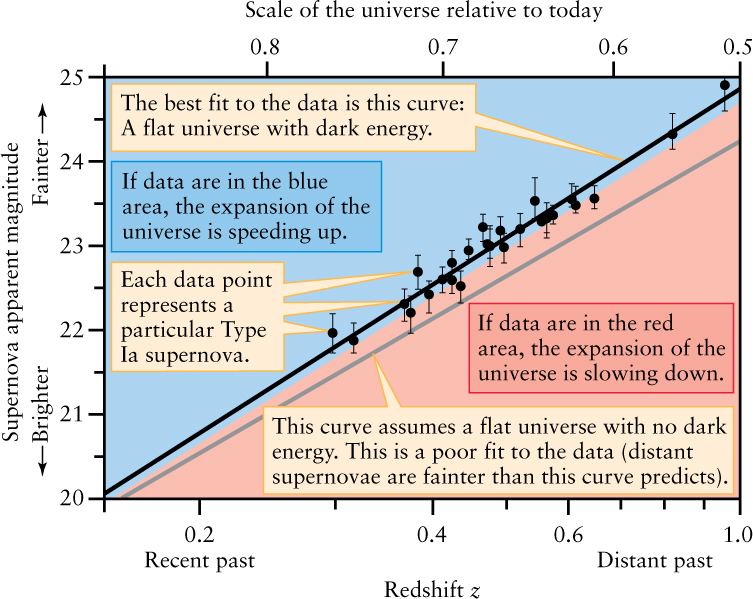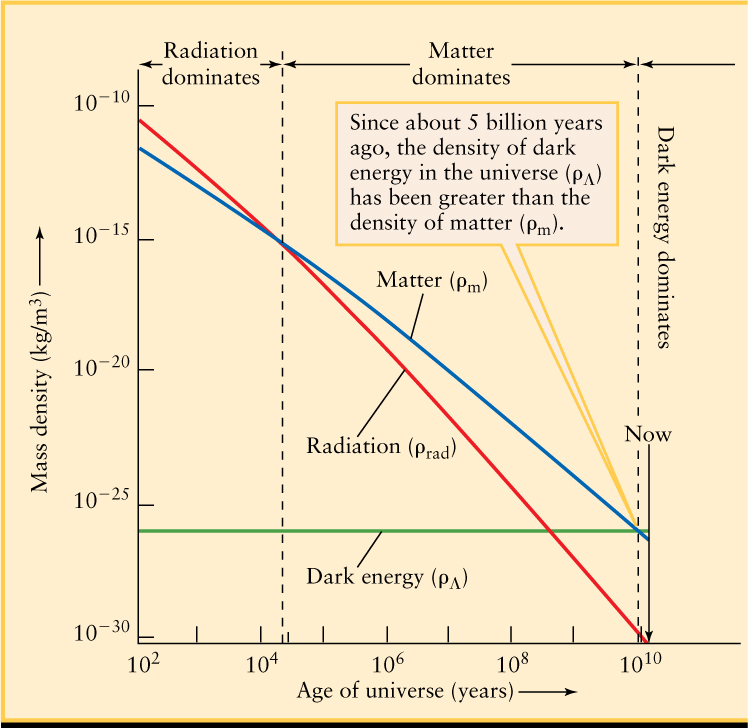25-7 Observations of distant supernovae reveal that we live in an accelerating universe
We have seen that the universe is expanding. But does the rate of expansion stay the same? Because there is matter in the universe, and because gravity tends to pull the bits of matter in the universe toward one another, we would expect that the expansion should slow down with time. (In the same way, a cannonball shot upward from the surface of Earth will slow down as it ascends because of Earth’s gravitational pull.) If there is a cosmological constant, however, its associated dark energy will exert an outward pressure that tends to accelerate the expansion. Which of these effects is more important?
Modeling the Expansion History of the Universe
To determine whether the expansion of the universe is slowing down or speeding up, astronomers study the relationship between redshift and distance for extremely remote galaxies. We see these galaxies as they were billions of years ago. If the rate of expansion was the same in the distant past as it is now, the same Hubble law should apply to distant galaxies as to nearby ones. But if the rate of expansion has either increased or decreased, we will find important deviations from the Hubble law.
To see how astronomers approach this problem, first imagine two different parallel universes. Both Universe #1 and Universe #2 are expanding at constant rates, so for both universes there is a direct proportion between recessional velocity v and distance d as expressed by the Hubble law v = H0d. Hence, a graph of distance versus recessional velocity for either universe is a straight line, as Figure 25-16a shows. The only difference is that Universe #1 is expanding at a slower rate than Universe #2. Hence, a galaxy at a certain distance from Earth in Universe #1 will have a slower recessional velocity than a galaxy at the same distance from Earth in Universe #2. As a result, the graph of distance versus recessional velocity for slowly expanding Universe #1 (shown in blue) has a steeper slope than the graph for rapidly expanding Universe #2 (shown in green). Keep this observation in mind: A slower expansion means a steeper slope on a graph of distance versus recessional velocity.

Now consider our universe and allow for the possibility that the expansion rate may change over time. If we observe very remote galaxies, we are seeing them as they were in the remote past. If the expansion of the universe in the remote past was slower or faster than it is now, the slope of the graph of distance versus recessional velocity will be different for those remote galaxies. If the expansion was slower, then the slope will be steeper for distant galaxies (shown in blue in Figure 25-16b); if the expansion was faster, the slope will be shallower for distant galaxies (shown in green in Figure 25-16b). In either case, there will be a deviation from the straight-line Hubble law (shown in red in Figure 25-16b).
Measuring Ancient Expansion with Type Ia Supernovae
Which of the possibilities shown in Figure 25-16b represents the actual history of the expansion of our universe? In Section 23-5 we looked at the observed relationship between distance and recessional velocity for galaxies. Figure 23-16 is a plot of some representative data. The data points appear to lie along a straight line, suggesting that the rate of cosmological expansion has not changed. (Figure 23-16 is actually a graph of recessional velocity versus distance, not the other way around. But a straight line on one kind of graph will be a straight line on the other, because in either case there is a direct proportion between the two quantities being graphed.) However, the graph in Figure 23-16 was based on measurements of galaxies no farther than 400 Mpc (1.3 billion ly) from Earth, which means we are looking only 1.3 billion years into the past. The straightness of the line in Figure 23-16 means only that the expansion of the universe has been relatively constant over the past 1.3 billion years—only 10% of the age of the universe and a relatively brief interval on the cosmic scale.
740
Now suppose that you were to measure the redshifts and distances of galaxies several billion light-years from Earth. The light from these galaxies has taken billions of years to arrive at your telescope, so your measurements will reveal how fast the universe was expanding billions of years ago. To determine the expansion, we need a technique that will allow us to find the distances to these very remote galaxies. We saw in Section 23-4 that one way to determine distances is to identify Type Ia supernovae in such galaxies. These supernovae are among the most luminous objects in the universe, and hence can be detected even at extremely large distances (see Figure 23-14). The maximum brightness of a supernova tells astronomers its distance through the inverse-square law for light, and the redshift of the supernova’s spectrum tells them its recessional velocity. As an example, the image that opens this chapter shows Type Ia supernovae with redshifts z = 1.010, 1.230, and 1.390, corresponding to recessional velocities of 60%, 67%, and 70% of the speed of light. We see these supernovae as they were 7.7 to 9.0 billion years ago, when the universe was less than half of its present age.
In 1998, two large research groups—the Supernova Cosmology Project, led by Saul Perlmutter of Lawrence Berkeley National Laboratory, and the High-Z Supernova Search Team, led by Brian Schmidt of the Mount Stromlo and Siding Springs Observatories in Australia—reported their results from a survey of Type Ia supernovae in galaxies at redshifts of 0.2 or greater, corresponding to distances beyond 750 Mpc (2.4 billion ly). Figure 25-17 shows some of their data, along with more recent observations, on a graph of apparent magnitude versus redshift. Recall that a greater apparent magnitude corresponds to a dimmer supernova (see Section 17-3), which means that the supernova is more distant. A greater redshift implies a greater recessional velocity. Hence, this graph is basically the same as those in Figure 25-16 (distance versus recessional velocity).

741
To interpret these results, we need guidance from relativistic cosmology. This field provides a theoretical description of the universe and its expansion, based on Einstein’s general theory of relativity, and was developed in the 1920s by Alexander Friedmann in Russia, Georges Lemaître in France, and Willem de Sitter in the Netherlands. Given values of the mass density parameter Ωm and the dark energy density parameter ΩΛ, cosmologists can use the equations of relativistic cosmology to predict how the expansion rate of the universe should change over time. Such predictions can be expressed as curves on a graph of distance versus redshift such as Figure 25-17.
The lower, gray curve in Figure 25-17 shows what would be expected in a flat universe with Ω0 = 1.00 but with no dark energy, so that ΩΛ = 0 and Ωm = Ω0 (that is, the density parameter is due to matter and radiation alone). In this model, and in fact in any model whose curve lies in the red area in Figure 25-17, the absence of dark energy means that gravitational attraction between galaxies would cause the expansion of the universe to slow down with time. Hence, the expansion rate would have been greater in the past (compare with the green curve in Figure 25-16b).
In fact, the data points in Figure 25-17 are almost all in the blue region of the graph, and agree very well with the curve shown in black. This curve also assumes a flat universe, but with an amount of dark energy consistent with the results from the cosmic microwave background (Ωm = 0.24, ΩΛ = 0.76, Ω0 = Ωm + ΩΛ = 1.00). In this model, and indeed in any model whose curve lies in the blue region of Figure 25-17, dark energy has made the expansion of the universe speed up over time. Hence, the expansion of the universe was slower in the distant past, which means that we live in an accelerating universe.
Just like the blue curve in Figure 25-16b, the data in Figure 25-17 show that supernovae of a certain brightness (and hence a given distance) have smaller redshifts (and hence smaller recessional velocities) than would be the case if the expansion rate had always been the same. These data provide compelling evidence of the existence of dark energy.
Roughly speaking, the data in Figure 25-17 indicate the relative importance of dark energy (which tends to make the expansion speed up) and gravitational attraction between galaxies (which tends to make the attraction slow down). Thus, these data tell us about the difference between the values of the dark energy density parameter ΩΛ and the matter density parameter Ωm. By contrast, measurements of the cosmic microwave background (Section 25-6) give information about Ω0, equal to the sum of ΩΛ and Ωm. Observations of galaxy clusters (Section 25-5) set limits on the value of Ωm by itself (which includes visible and dark matter). By combining these three very different kinds of observations as shown in Figure 25-18, we can set more stringent limits on both ΩΛ and Ωm.

Taken together and combined with other observations, all these data suggest the following values.

In each case, the number after the ± sign is the uncertainty in the value.
Dark energy became the dominant form of energy in the universe about the same time that our solar system formed
This collection of numbers points to a radically different model of the universe from what was suspected just a few years ago. In the 1980s there was no compelling evidence for an accelerating expansion of the universe, so it was widely assumed that ΩΛ = 0. Evidence from distant galaxies suggested a flat universe, so it was presumed that Ωm = 1. Figure 25-18 shows that modern data rule out this model.
The model we are left with is one in which the universe is suffused with a curious dark energy due to a cosmological constant. Unlike matter or radiation, whose average densities decrease as the universe expands and thins out, the average density of this dark energy remains constant throughout the history of the universe (Figure 25-19). The dark energy was relatively unimportant over most of the early history of the universe. Today, however, the density of dark energy is greater than that of matter (ΩΛ is greater than Ωm). In other words, we live in a dark-energy−dominated universe.

CONCEPT CHECK 25-14
What assumption must one make about Type Ia supernovae in order to use them to measure distances to galaxies?
742
Cosmic Expansion: From Slowing Down to Speeding Up

 As Figure 25-19 shows, the dominance of dark energy is a relatively recent development in the history of the universe. Prior to about 5 billion years ago, the density of matter should have been greater than that of dark energy. Hence, we would expect that up until about 5 billion years ago, the expansion of the universe should have been slowing down rather than speeding up. Recently, astronomers have found evidence of this picture by using the Hubble Space Telescope to observe extremely distant Type Ia supernovae with redshifts z greater than 1. (The image that opens this chapter shows three of these supernovae.) When astronomers compare the distance to these supernovae (determined from their brightness) to their redshifts, they find that the redshifts are greater than would be the case if the expansion of the universe had always been at the same rate or had always been speeding up (see Figure 25-16). This is just what would be expected if the expansion was slowing down in the very early universe. After about 5 billion years ago, the effects of dark energy became dominant and the expansion began to speed up.
As Figure 25-19 shows, the dominance of dark energy is a relatively recent development in the history of the universe. Prior to about 5 billion years ago, the density of matter should have been greater than that of dark energy. Hence, we would expect that up until about 5 billion years ago, the expansion of the universe should have been slowing down rather than speeding up. Recently, astronomers have found evidence of this picture by using the Hubble Space Telescope to observe extremely distant Type Ia supernovae with redshifts z greater than 1. (The image that opens this chapter shows three of these supernovae.) When astronomers compare the distance to these supernovae (determined from their brightness) to their redshifts, they find that the redshifts are greater than would be the case if the expansion of the universe had always been at the same rate or had always been speeding up (see Figure 25-16). This is just what would be expected if the expansion was slowing down in the very early universe. After about 5 billion years ago, the effects of dark energy became dominant and the expansion began to speed up.
743
ANALOGY
If you see a red light up ahead while driving, you would probably apply the brakes to make the car slow down. But if the light then turns green before your car comes to a stop, and the road ahead is clear, you would step on the gas to make the car speed up again. The expansion of the universe has had a similar history. The mutual gravitational attraction of all the matter in the universe means that “the brakes were on” for about the first 9 billion years after the Big Bang, so that the expansion slowed down. But for about the past 5 billion years, dark energy has “had its foot on the gas,” and the expansion has been speeding up.
So far, observations of distant supernovae support dark energy that is described by a cosmological constant. If dark energy truly is a cosmological constant, the density of dark energy will continue to remain constant, as shown in Figure 25-19. Due to the effects of this dark energy, the universe will keep on expanding forever, and the rate of expansion will continue to accelerate. Eventually, some 30 billion years from now, the universe will have expanded so much that only a thousand or so of the nearest galaxies will still be visible. The billions of other galaxies that we can observe today will have moved so far away from us that their light will have faded to invisibility. Furthermore, they will be moving away from us so rapidly that what light we do receive from them will have been redshifted out of the visible range.
There may be other explanations for dark energy besides a cosmological constant, however. Several physicists have proposed a type of dark energy whose density decreases slowly as the universe expands. Depending on how the density of dark energy evolves over time, the universe could continue to expand or could eventually recollapse on itself. Future observations, including space-based measurements of both the cosmic background radiation and of Type Ia supernovae, should help resolve the nature of the mysterious dark energy.
What Is Dark Energy?
While the evidence for an accelerating universe is strong enough that its discoverers were awarded the Nobel Prize in Physics in 2011, the nature of the dark energy implied by this acceleration is far from clear. The physical interpretation of the cosmological constant is that there is an energy associated with space itself. With a cosmological constant, the more space there is, the more energy there is. In other words, as the universe expands, the additional space leads to more energy. Just as the energy content in the universe determines its shape (Section 25-6), the energy content can also cause the universe to accelerate its expansion, and this is what dark energy is doing. But, how does energy arise from seemingly empty space?
The answer might come from virtual particle pairs—imperceptible particles made of matter and antimatter. As mentioned in Section 21-9, quantum physics reveals that seemingly empty space is not so empty after all. Everywhere, at all times, virtual particle pairs pop up from nothing and then disappear again on very short timescales. While the virtual particles themselves are not directly observable, the phenomenon is real and secondary effects of the virtual particles have been observed. In fact, virtual particle effects between microscopic nanotechnology devices are strong enough that this phenomenon can produce practical problems—forces that cause some devices to clump together. In Chapter 26, we will also discuss virtual particles for their possible role in the early universe.
Because virtual particles appear in the otherwise empty “vacuum” of space, they are called vacuum fluctuations. Overall, the effect of virtual particles, or vacuum fluctuations, is to produce an energy associated with space itself. This seems to be just what is needed to produce a cosmological constant. However, there is a big problem with this explanation for dark energy. When the effects of virtual particles are calculated, they predict a cosmological constant that is 100 orders of magnitude larger than what is actually observed; that number has a one with a hundred zeroes after it! With such a large numerical discrepancy between theory and observation, our current understanding of virtual particles and vacuum fluctuations cannot explain dark energy. Perhaps a modification of the vacuum fluctuation model can explain dark energy, but each theoretical modification also introduces new problems.
There are other theories offered to explain dark energy. Some propose that Einstein’s general theory of relativity needs modifying on very large scales. Others propose that we are in a special part of the universe that only gives the appearance of accelerated expansion, so that there is actually no dark energy at all. However, each theory has its own difficulties and no explanation has gained wide acceptance. While the observations march forward, they are difficult, and dark energy is likely to remain one of the universe’s greatest mysteries for some time to come.